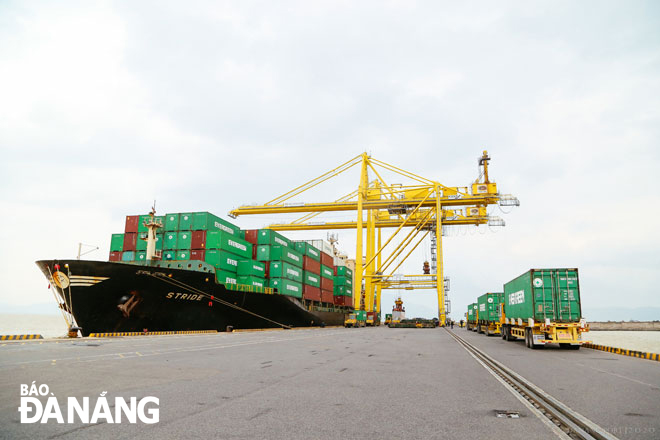Positive changes in Da Nang's export structure
The 2015 - 2020 period saw a significant hike in Da Nang’s export value. The export turnover reached an estimated 1.6 billion US$ last year, bringing the total earnings from exports to over 7.6 billion US$ over the 2016- 2020 period, with an average annual increase of 5.9%.
 |
| STRIDE container ship brought the 500,000th TEU to the Da Nang Port on 4 December (Photo coutersy of the Da Nang Port) |
The structure of exports has continued to positively shift from agricultural, preliminary and raw aquatic products to processed, manufactured and high technology products.
As for export markets, Da Nang-based enterprises have been on course to maintain their time-honoured traditional markets, in tandem with seeking new ones worldwide. Up to now, ‘made -in- Da Nang’ goods have been exported to about 120 countries and territories all over the world.
With regard to the average export market structure over the 2016 - 2020 period, Japan accounted for 30 - 35%, the U.S.A 17-20%, the European Union (EU) 15 - 16%, China 10 - 11% in the city’s total exports.
It is high time for Da Nang to take a number of solutions to promote the restructuring of merchandise exports by 2025, ensuring that the average annual export growth rate in the 2021 - 2025 period will increase by 7 - 8%.
Boosting infrastructure development for exports
In terms of infrastructure development for exports, it is necessary to focus on accelerate the construction of the Hi-tech and the dedicated IT parks, going hand in hand with increasing investment attraction in the fields of high tech and support industries.
It is a highly recommended to call for even more investment from private businesses into the provision of logistics services, expand warehouses and freight yards equipped with modern and large capacity loading and unloading facilities, and also importantly, apply advanced technologies in managing and tracking exported and imported goods.
In the coming time, heed will be paid to developing a 20ha logistics centre in Hoa Nhon Commune, Hoa Vang District, and a goods distribution site covering an area of 50ha for serving temporary import, re-export and transit goods in the city.
Also, terminal handling and port storage charges, plus related fees should be set at reasonable rates so as to help reduce product costs and increase the locally-made products’ competitiveness in the market.
In order to meet the increasing demand for handling container cargos, focus will be on upgrading the Tien Sa Port’s infrastructure system, and constructing the Son Tra Port as a proper replacement for the Han River Port, which has been converted into a tourist wharf.
All-out efforts must be made to speed up the construction of such key projects as Lien Chieu mega-port, the relocation of the Da Nang Railway Station and urban redevelopment.
Accelerating trade promotion programmes
As for export promotion orientations, in the time ahead, the emphasis should be placed on boosting the EU export market, and promoting investment and trade cooperation between Da Nang and other parts of the world.
It is a good idea to facilitate local exporters to reap the great benefits from international commitments and trade agreements to which Viet Nam is a party, promote the connection of domestic and export markets, and form a network linking trade - service - transport enterprises to one another.
More highly effective measures should be taken to make Da Nang’s goods directly penetrate into the distribution system of major European supermarkets, and set up Da Nang’s trade promotion agencies in foreign countries on a trial basis in order to speed up trade promotion and export market expansion.
In terms of finance, focus should be on releasing priority policies to facilitate local exporters to access, in an easier manner, credit packages, especially preferential loans from the Da Nang Development Investment Fund. Commercial bank must offer preferential loans to small and medium-sized enterprises and those active in support industries and exports.
In partiucular, businesses must be encouraged to register for export credit insurance (ECI), which protects an exporter of products and services against the risk of non-payment by a foreign buyer. In other words, ECI significantly reduces the payment risks associated with doing business internationally by giving the exporter conditional assurance that payment will be made if the foreign buyer is unable to pay. Simply put, exporters can protect their foreign receivables against a variety of risks that could result in non-payment by foreign buyers.
Last, but not least, a heed should be paid to implementing a human resource development project in Da Nang for the 2021 - 2030 period, especially training skilled workers and management staffers to meet the requirements of handling the would-be investment projects, especially in the hi-tech sector in favour for serving the Hi-tech and IT parks.
By LE DUC VIEN- Translated by A.T








